Winter is nearly over, the ospreys will be returning shortly, and the spring round of boat shows is on the horizon. Most of our boatshops are reporting a busy winter and are anticipating an equally busy spring. But first, my apologies to
Peter Bell and Hartge Yacht Yard for incorrectly identifying Peter’s location in last month’s column. In this business the devil is in the proofreading. We’ll try to do better.
Joe Reid at Mast and Mallet in Edgewater, MD, leads off this month: “Indoors, (we have) construction of an 11-foot mahogany bow sprit for a 38-foot Ingrid design, laminated and saturated with WEST epoxy, finished with a white polyurethane paint. A Seaway 24 is in for new cockpit and helm seating changes. We will also check and upgrade all mechanical systems and top it off with a bit of varnish on the bright windshield. The 28-foot Pacemaker has returned this season for upgrading the interior finish with new headliner and some faux teak and holly for the floors and cockpit sole. Update on the Chesapeake 22 with an inboard/outboard well: It’s powered with an Evinrude ETEC 90. Sea trials went incomplete, when we discovered the well needed some modification. Back to the stable. Trials will resume in the spring.”
Alaina Wine of Hartge Yacht Yard in Galesville, MD, sends us this update from Alex Schlegel.
“On the 55-foot Trumpy, we are progressing on the frame and plank repairs described last month. We have not taken it all apart at once, so the boat will keep its shape. We removed some planks, about halfway from the stern to the bow, and worked our way forward, replacing frames and planks. About a foot of each original steamed and bent frame is broken and deteriorated where bolted to a stringer. New pieces of white oak are sawn and fit, and then a three-foot or longer sister frame of oak is sawn, fit, and fastened to the old frame, stringer, and short replacement piece. The inner 7/16-inch white cedar planks are installed with the butts on frames, and the 15/16-inch thick outer sapele planks are installed with butt blocks inside the cedar planks. We have a good source for the inner planking of white cedar. The original outer planks are Honduras mahogany but that wood is no longer available. We can get shorter lengths of ‘genuine’ mahogany from Peru but not long lengths. We are using sapele, a good strong and durable substitute.
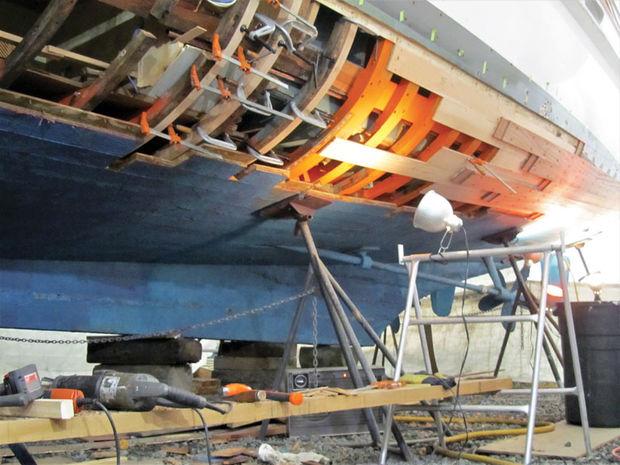
Another attractive classic, wooden boat we have repaired and maintained for many years is a 1969 Trojan 33, powered by a pair of its original 289 Ford Interceptors. Exhaust manifolds and risers don’t last very long. When the original Interceptor parts were no longer made, Osco manifolds and risers were installed. Now that Osco no longer makes parts for these engines, we switched to Barr. The Barr manifold is shaped so that a socket for the 18-millimeter spark plugs would not fit. A 14-millimeter spark plug socket would fit. Bunky Hines found online a threaded bushing made to fix this problem. They were close to working but not quite right, so Pete Appell machined their length and seat bevels to match the engine and spark plugs. Thanks to our technicians at Hartge’s who are resourceful and intuitive, it makes our services quite interesting and very productive.
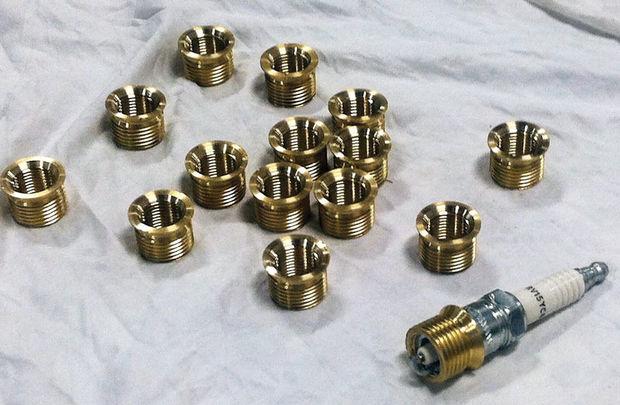
A pair of powerboats built by Sabre Yachts, originally a sailboat builder, are shrink wrapped and on shore, side by side, for the winter: a 1989 Sabreline 36 Fast Trawler and a 2006 Salon Express 38. The newer Sabres are a style of powerboat that sailors buy: pleasing sheer, some teak, not too much superstructure, and nice size cockpit in the stern. These Sabres’ owners, both longtime and active sailors, are having us do typical repairs and maintenance to hardware, plumbing, and engines. The Sabreline is being prepared for the Great Loop with bigger batteries, bigger alternators, electrical system upgrades, and lots of engine preventative maintenance on the pair of 250-hp Detroit 8.2 4-stroke V-8 diesels. The Sabre 38 has a pair of 420-hp Yanmar 6LY2As.”
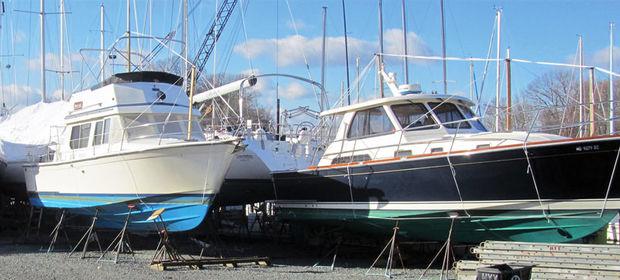 Dave Hannam with Classic Watercraft Restoration (CWR) in Annapolis
Dave Hannam with Classic Watercraft Restoration (CWR) in Annapolis reports on yet another family heirloom with the arrival of the 1938 18-foot Century Sea Maid 95 which recently came in from Falls Church, VA. “This ole woody was acquired by the father, with plans to restore with his eldest son in mind, as a project to be handed down. After the father passed, the son took over and continued on with the restoration with his friends and family in his garage. After some 20 years, it was time for his brother Robert to take over the project. So his son Neal and their good friend Tim delivered the boat to the shop. CWR is in the process of laying out the new deck framing and new stringers, building the new deck planking, and building an original interior layout. The shop is once again filled with the sweet smell of mahogany!”
[gallery link="file" columns="2" size="medium" ids="18443,18444"]
From building #2 at
Bandy Boats at Casa Rio Marina in Mayo, MD, Reid Bandy brings us up to date on his Rybovitch project. “The past nine months have been long grueling days followed by dreamy visions of the next steps, wake up, and do it again. All the significant work is falling into place: the reframing, cold molding, keel and chine replacement, fiberglass outer hull sheathing, priming and painting, and rolling over and rolling over again. Once the hull workings were complete, we moved on to the driveline procurement and installation. Since we took the lines off this boat and entered everything in Rhino, the driveline install has been simple as long as we remain dedicated to following the drawings.
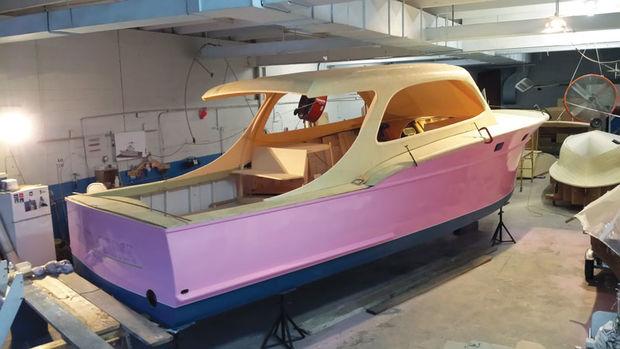
We had beautiful engine supports crafted to our templates by an artisan in Wanchese, NC, Jeff Hathaway. He is the motor mount man. He has created mounts for some of the finest sportfish boats in the world and currently works with John Bayliss. We procured 12-foot, 2.5-inch drive shafts from Bayliss’s salvage pile and had Paul Spencer’s crew machine them to our specs. Another Wanchese vendor created rudders and struts to our templates. The fuel tanks came from the good folks at Atlantic Coastal Welding again to our drawings, and the custom exhaust came courtesy of Centek in Georgia. It has been wonderful working with these professionals.
We are now finishing the fabrication of all the custom parts that comprise the rest of the build to include the foredeck, house, bulkheads, interior partitions, bunks, floors, bridge deck, cockpit, flybridge, hardtop, and washboards. We have created several jigs to build these parts accurately to aid assembly. These parts are the heart of our weight-saving program, and are all built with foam and epoxy. We are staying true to the original design, as the flybridge creates the ultimate fish-spotting platform, and the open day-boat layout creates a single, open space for people to move about and socialize, while always having the ability to look back and see the baits. We anticipate the composite parts to save 2000 pounds with another 2000 pounds saved in the hull and driveline. We look forward to a spring launch and anticipate offshore fishing this summer.
The carbon fiber 24-foot lightweight is moving very well through the shop. The hull and deck have been joined. The console and lean post are together, and the finish is being applied to the hull. I like Awlgrip products, but we will use automotive basecoat clear coat on this project as I have chosen Dodge Go Mango for her splash of color. This boat has an all-up hull weight of 450 pounds (no motor, no gas). She will go overboard very soon.
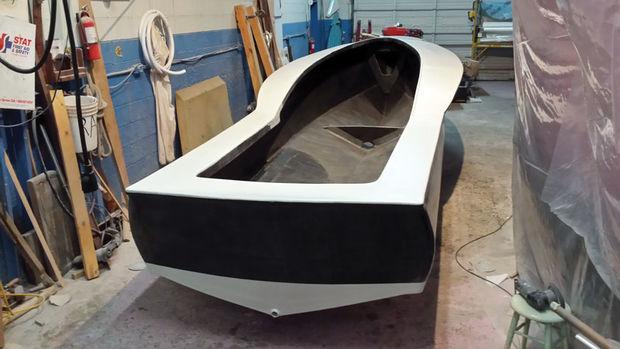 Meg Roney of Mathews Brothers Boats in Denton, MD,
Meg Roney of Mathews Brothers Boats in Denton, MD, winds up this month’s reports: “The fiberglass crew has been busy laying up the hull and deck components for a new Eastport 32, and engine placement will begin soon. A few of our other winter projects include repairing stress cracks on the deck of a Legacy 28, installing heat/AC and a generator on a Wilbur 34, among many small repairs and varnish jobs. All the while, the approaching spring rush is in the air. We have the most storage boats we’ve had to date and are working diligently to have them in tip top shape for delivery in the spring.”
[gallery columns="2" link="file" size="medium" ids="18448,18447"]
by Captain Rick Franke Another attractive classic, wooden boat we have repaired and maintained for many years is a 1969 Trojan 33, powered by a pair of its original 289 Ford Interceptors. Exhaust manifolds and risers don’t last very long. When the original Interceptor parts were no longer made, Osco manifolds and risers were installed. Now that Osco no longer makes parts for these engines, we switched to Barr. The Barr manifold is shaped so that a socket for the 18-millimeter spark plugs would not fit. A 14-millimeter spark plug socket would fit. Bunky Hines found online a threaded bushing made to fix this problem. They were close to working but not quite right, so Pete Appell machined their length and seat bevels to match the engine and spark plugs. Thanks to our technicians at Hartge’s who are resourceful and intuitive, it makes our services quite interesting and very productive.
Another attractive classic, wooden boat we have repaired and maintained for many years is a 1969 Trojan 33, powered by a pair of its original 289 Ford Interceptors. Exhaust manifolds and risers don’t last very long. When the original Interceptor parts were no longer made, Osco manifolds and risers were installed. Now that Osco no longer makes parts for these engines, we switched to Barr. The Barr manifold is shaped so that a socket for the 18-millimeter spark plugs would not fit. A 14-millimeter spark plug socket would fit. Bunky Hines found online a threaded bushing made to fix this problem. They were close to working but not quite right, so Pete Appell machined their length and seat bevels to match the engine and spark plugs. Thanks to our technicians at Hartge’s who are resourceful and intuitive, it makes our services quite interesting and very productive.
 A pair of powerboats built by Sabre Yachts, originally a sailboat builder, are shrink wrapped and on shore, side by side, for the winter: a 1989 Sabreline 36 Fast Trawler and a 2006 Salon Express 38. The newer Sabres are a style of powerboat that sailors buy: pleasing sheer, some teak, not too much superstructure, and nice size cockpit in the stern. These Sabres’ owners, both longtime and active sailors, are having us do typical repairs and maintenance to hardware, plumbing, and engines. The Sabreline is being prepared for the Great Loop with bigger batteries, bigger alternators, electrical system upgrades, and lots of engine preventative maintenance on the pair of 250-hp Detroit 8.2 4-stroke V-8 diesels. The Sabre 38 has a pair of 420-hp Yanmar 6LY2As.”
A pair of powerboats built by Sabre Yachts, originally a sailboat builder, are shrink wrapped and on shore, side by side, for the winter: a 1989 Sabreline 36 Fast Trawler and a 2006 Salon Express 38. The newer Sabres are a style of powerboat that sailors buy: pleasing sheer, some teak, not too much superstructure, and nice size cockpit in the stern. These Sabres’ owners, both longtime and active sailors, are having us do typical repairs and maintenance to hardware, plumbing, and engines. The Sabreline is being prepared for the Great Loop with bigger batteries, bigger alternators, electrical system upgrades, and lots of engine preventative maintenance on the pair of 250-hp Detroit 8.2 4-stroke V-8 diesels. The Sabre 38 has a pair of 420-hp Yanmar 6LY2As.”
 Dave Hannam with Classic Watercraft Restoration (CWR) in Annapolis reports on yet another family heirloom with the arrival of the 1938 18-foot Century Sea Maid 95 which recently came in from Falls Church, VA. “This ole woody was acquired by the father, with plans to restore with his eldest son in mind, as a project to be handed down. After the father passed, the son took over and continued on with the restoration with his friends and family in his garage. After some 20 years, it was time for his brother Robert to take over the project. So his son Neal and their good friend Tim delivered the boat to the shop. CWR is in the process of laying out the new deck framing and new stringers, building the new deck planking, and building an original interior layout. The shop is once again filled with the sweet smell of mahogany!”
[gallery link="file" columns="2" size="medium" ids="18443,18444"]
From building #2 at Bandy Boats at Casa Rio Marina in Mayo, MD, Reid Bandy brings us up to date on his Rybovitch project. “The past nine months have been long grueling days followed by dreamy visions of the next steps, wake up, and do it again. All the significant work is falling into place: the reframing, cold molding, keel and chine replacement, fiberglass outer hull sheathing, priming and painting, and rolling over and rolling over again. Once the hull workings were complete, we moved on to the driveline procurement and installation. Since we took the lines off this boat and entered everything in Rhino, the driveline install has been simple as long as we remain dedicated to following the drawings.
Dave Hannam with Classic Watercraft Restoration (CWR) in Annapolis reports on yet another family heirloom with the arrival of the 1938 18-foot Century Sea Maid 95 which recently came in from Falls Church, VA. “This ole woody was acquired by the father, with plans to restore with his eldest son in mind, as a project to be handed down. After the father passed, the son took over and continued on with the restoration with his friends and family in his garage. After some 20 years, it was time for his brother Robert to take over the project. So his son Neal and their good friend Tim delivered the boat to the shop. CWR is in the process of laying out the new deck framing and new stringers, building the new deck planking, and building an original interior layout. The shop is once again filled with the sweet smell of mahogany!”
[gallery link="file" columns="2" size="medium" ids="18443,18444"]
From building #2 at Bandy Boats at Casa Rio Marina in Mayo, MD, Reid Bandy brings us up to date on his Rybovitch project. “The past nine months have been long grueling days followed by dreamy visions of the next steps, wake up, and do it again. All the significant work is falling into place: the reframing, cold molding, keel and chine replacement, fiberglass outer hull sheathing, priming and painting, and rolling over and rolling over again. Once the hull workings were complete, we moved on to the driveline procurement and installation. Since we took the lines off this boat and entered everything in Rhino, the driveline install has been simple as long as we remain dedicated to following the drawings.
 We had beautiful engine supports crafted to our templates by an artisan in Wanchese, NC, Jeff Hathaway. He is the motor mount man. He has created mounts for some of the finest sportfish boats in the world and currently works with John Bayliss. We procured 12-foot, 2.5-inch drive shafts from Bayliss’s salvage pile and had Paul Spencer’s crew machine them to our specs. Another Wanchese vendor created rudders and struts to our templates. The fuel tanks came from the good folks at Atlantic Coastal Welding again to our drawings, and the custom exhaust came courtesy of Centek in Georgia. It has been wonderful working with these professionals.
We are now finishing the fabrication of all the custom parts that comprise the rest of the build to include the foredeck, house, bulkheads, interior partitions, bunks, floors, bridge deck, cockpit, flybridge, hardtop, and washboards. We have created several jigs to build these parts accurately to aid assembly. These parts are the heart of our weight-saving program, and are all built with foam and epoxy. We are staying true to the original design, as the flybridge creates the ultimate fish-spotting platform, and the open day-boat layout creates a single, open space for people to move about and socialize, while always having the ability to look back and see the baits. We anticipate the composite parts to save 2000 pounds with another 2000 pounds saved in the hull and driveline. We look forward to a spring launch and anticipate offshore fishing this summer.
The carbon fiber 24-foot lightweight is moving very well through the shop. The hull and deck have been joined. The console and lean post are together, and the finish is being applied to the hull. I like Awlgrip products, but we will use automotive basecoat clear coat on this project as I have chosen Dodge Go Mango for her splash of color. This boat has an all-up hull weight of 450 pounds (no motor, no gas). She will go overboard very soon.
We had beautiful engine supports crafted to our templates by an artisan in Wanchese, NC, Jeff Hathaway. He is the motor mount man. He has created mounts for some of the finest sportfish boats in the world and currently works with John Bayliss. We procured 12-foot, 2.5-inch drive shafts from Bayliss’s salvage pile and had Paul Spencer’s crew machine them to our specs. Another Wanchese vendor created rudders and struts to our templates. The fuel tanks came from the good folks at Atlantic Coastal Welding again to our drawings, and the custom exhaust came courtesy of Centek in Georgia. It has been wonderful working with these professionals.
We are now finishing the fabrication of all the custom parts that comprise the rest of the build to include the foredeck, house, bulkheads, interior partitions, bunks, floors, bridge deck, cockpit, flybridge, hardtop, and washboards. We have created several jigs to build these parts accurately to aid assembly. These parts are the heart of our weight-saving program, and are all built with foam and epoxy. We are staying true to the original design, as the flybridge creates the ultimate fish-spotting platform, and the open day-boat layout creates a single, open space for people to move about and socialize, while always having the ability to look back and see the baits. We anticipate the composite parts to save 2000 pounds with another 2000 pounds saved in the hull and driveline. We look forward to a spring launch and anticipate offshore fishing this summer.
The carbon fiber 24-foot lightweight is moving very well through the shop. The hull and deck have been joined. The console and lean post are together, and the finish is being applied to the hull. I like Awlgrip products, but we will use automotive basecoat clear coat on this project as I have chosen Dodge Go Mango for her splash of color. This boat has an all-up hull weight of 450 pounds (no motor, no gas). She will go overboard very soon.
 Meg Roney of Mathews Brothers Boats in Denton, MD, winds up this month’s reports: “The fiberglass crew has been busy laying up the hull and deck components for a new Eastport 32, and engine placement will begin soon. A few of our other winter projects include repairing stress cracks on the deck of a Legacy 28, installing heat/AC and a generator on a Wilbur 34, among many small repairs and varnish jobs. All the while, the approaching spring rush is in the air. We have the most storage boats we’ve had to date and are working diligently to have them in tip top shape for delivery in the spring.”
[gallery columns="2" link="file" size="medium" ids="18448,18447"]
by Captain Rick Franke
Meg Roney of Mathews Brothers Boats in Denton, MD, winds up this month’s reports: “The fiberglass crew has been busy laying up the hull and deck components for a new Eastport 32, and engine placement will begin soon. A few of our other winter projects include repairing stress cracks on the deck of a Legacy 28, installing heat/AC and a generator on a Wilbur 34, among many small repairs and varnish jobs. All the while, the approaching spring rush is in the air. We have the most storage boats we’ve had to date and are working diligently to have them in tip top shape for delivery in the spring.”
[gallery columns="2" link="file" size="medium" ids="18448,18447"]
by Captain Rick Franke